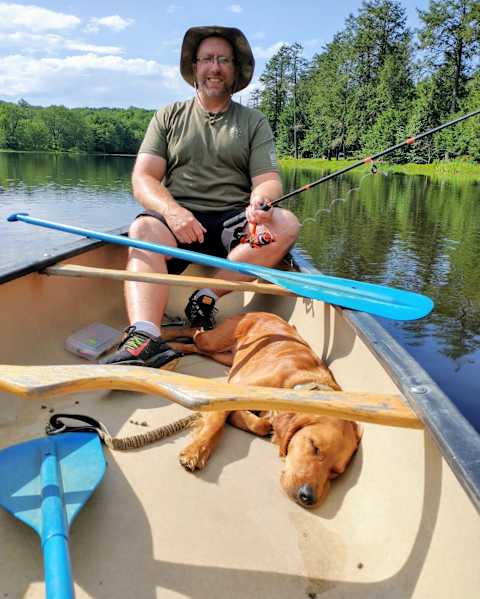Veterans Day is a federal holiday meant to honor those who have served in the military. In celebration of Veterans Day, we sat down with Francess “Myrph” McMahon of Stand With Me, a nonprofit organization that places service dogs with veterans. Stand With Me takes a unique approach by teaching veterans to train their own dogs instead of bearing the expense of a serviced trained dog. Here are 5 questions we asked to learn more about Stand With Me and their important work with veterans and service dogs.

1. What is the mission of Stand With Me and how was it founded?
The goal of Stand With Me is to teach veterans with service-connected mental health disabilities to train their own dogs to become a service dog. The organization also helps veterans to find and pay for a puppy suitable for service work if they don’t already have their own dog.
Myrph has been a professional dog trainer for 45 years. She’s worked with service dogs closely across her career. Nearly a decade ago she started receiving multiple requests from veterans, all of them echoing a similar story. Because the price of a service trained dog is too costly, veterans asked Myrph for training help. By chance, one of her students happened to be a lawyer who advised her on starting a 501(c)(3) nonprofit pro bono.
Myrph is the only full-time trainer at Stand With Me, however, she has a team of volunteer trainers who fill in as needed. This team of volunteer trainers helps give attention to each Service-Dog Team-In-Training during monthly group classes. For the rest of the month, Myrph holds weekly individual lessons in her home. She works with veterans to help train their dogs in a private, secure setting before slowly moving to more public locations.

2. In what ways do service dogs help the veterans at Stand With Me?
The purpose of a service dog is to help their veteran handler function in their daily lives, especially in public settings.
One of the most popular tasks required of a service dog is personal space assistance. For various reasons, a handler needs to be able to maintain a certain amount of space in a public setting. If someone approaches the handler’s personal space in a public setting, it may cause them to feel unsafe or trigger an episode. The service dog can perform a stand-stay at a specific spot to block the person from getting too close. This is important for public locations like a grocery store checkout line where someone’s movement is limited.
Other tasks that service dogs are trained to perform include:
- Waking up the handler within the first 30 seconds of a nightmare to help them get a full night’s sleep
- Leaning or laying down on the handler to create pressure and reduce anxiety
- Picking up objects for handlers with back injuries
- Helping handlers navigate toward the exit of public places if they experience a dissociative episode which may lead them to forget where they are.
3. Can any breed of dog become a service dog?
If the veteran is looking for a new puppy, Myrph recommends certain breeds and traits. Golden and Labrador Retrievers are reliable service dog breeds, for example. She looks for show and pet dogs rather than field dogs since the latter can have so much more energy. Many breeders breed for specific temperaments for service dogs. Myrph has a network of reputable breeders who have either donated or sold puppies that have gone on to become excellent service dogs.
If a veteran comes in with their own dog, Myrph does not reject any of them based on their breed mix. There are certain breeds that aren’t at the top of her list, but she believes there are always exceptions in every breed. Some of the star students at Stand With Me include a Siberian Husky, a German Shepherd, and an American Pit Bull Terrier mix.
She also doesn’t have a preference between purebred and mixed breed dogs. The only stipulation is that they do not allow giant breeds since a service dog needs to be able to fit in compact places like under a table at a restaurant or in an airplane. But even this rule has its exception based on certain handlers’ needs: Two Great Danes are currently enrolled in the program to assist larger handlers with keeping their balance. They are being trained with the stipulation that they won’t be placed in tight spaces.

4. How do service dogs differ from show and performance dogs?
There’s an idea that show and performance dogs can only be trained in one field, but Myrph disagrees with that approach. She explains how a dog’s behavior is very reactive and they respond to the environment around them. A show dog can also run agility and perform in obedience trials. To that extent, they can also work as a service dog with proper training.
The key to training a show or performance dog as a service dog is making sure they have the proper temperament. For example, some show and performance dogs aren’t raised in the usual home setting around multiple people. This would make it difficult for them to transition into service dog work. But if the breeder socializes their dogs around people from a young age, they would make a good candidate.
5. What misconceptions about service dogs would you like to correct?
There’s a belief that service dogs are only for people with noticeable physical disabilities, such as blind people or people in wheelchairs. Some veterans with service dogs are asked publicly, “Who are you training the dog for?” because there doesn’t appear to be anything physically wrong with them. This is a problematic question because it puts the handler in a situation where they have to explain their disability and mental health issues carry a stigma with them. Myrph explains the need for public education around service dog etiquette to prevent conversations like these from happening.
She also stresses the difference between service dogs and Emotional Support Animals. Service dogs are allowed public access rights under the Americans with Disabilities Act, but ESAs do not have that same legal right. Service dogs require a certain standard of behavior under the law. Most reputable service dog organizations have their own set of training and certification to ensure the dogs they work with are compliant with this behavioral standard. ESA’s only need to be prescribed to a patient by a mental health professional. They are not held to the same behavioral standard by law.
The ADA allows business owners/security guards to excuse a dog who’s disrupting the flow of business. Many people who don’t have trained tested certified service dogs are breaking the law because their dog isn’t performing under the required behavior expectations.
Another important distinction is therapy dogs. These dogs are tested and certified as a team with their handler. These teams are expected to hold a certain level of behavior since they work in places like hospice care or with students with emotional needs. Once they’re certified, these teams are covered with a large liability insurance policy. They do not have the same public access rights as a service dog.
One of the biggest misconceptions about service dogs is that they live a life of drudgery where they’re always working. Myrph emphasized that this isn’t true and they have privileged, high-quality lives like most family pets. They do not have to stand still for hours on end and ignore people. When they’re “off duty” they get to run around and play like any other dog. Some dog shelters and breeders do not allow their animals to become service dogs because of this misconception, but it’s not based in fact.

Bonus: What Stand With Me service dog story are you proudest of ?
Many stories came to Myrph’s mind when asked this question, but the one that stood out the most belongs to a handler who wanted to pursue an engineering degree. He spent 14 years in the military and served 3 active combat deployments. He suffered from back injuries that made it difficult to bend over and pick things up. He also had flashbacks and anxiety which would prevent him from functioning in a classroom setting.
Once he trained his service dog, she was able to sense when a flashback was about to happen. She’d climb on his lap and nudge his chin to keep his focus in the present. With her help, he was able to enroll in school and even finished his first year at the top of his class. Unfortunately, his dog passed away and he had to drop out of school. Stand With Me was able to hold a fundraiser to help him find a new puppy. Now he’s back in class training his new dog. He’s looking forward to going back to school once the puppy is fully trained.
If you want to help Stand With Me and the veterans enrolled in this program, the best way to support them is through donations. The average cost of a fully-trained service dog given by a nonprofit runs between $25,000 and $30,000. Stand With Me’s maximum cost for students is $5,000. They’re able to keep that cost low through the help of donations.
Besides donating, you can also volunteer to help run Stand With Me’s social media efforts. If you’re in the Binghamton, New York area, you can help transport veterans who are otherwise unable to drive.
Follow Stand With Me on Facebook to show your support. You can also ask friends to make donations to them for your birthday to help raise even more money if you aren’t able to make recurring donations.
And of course, educating people you know on the work of service dogs based on what you’ve read here will go a long way to helping veterans and service dogs everywhere and destigmatizing mental health.














